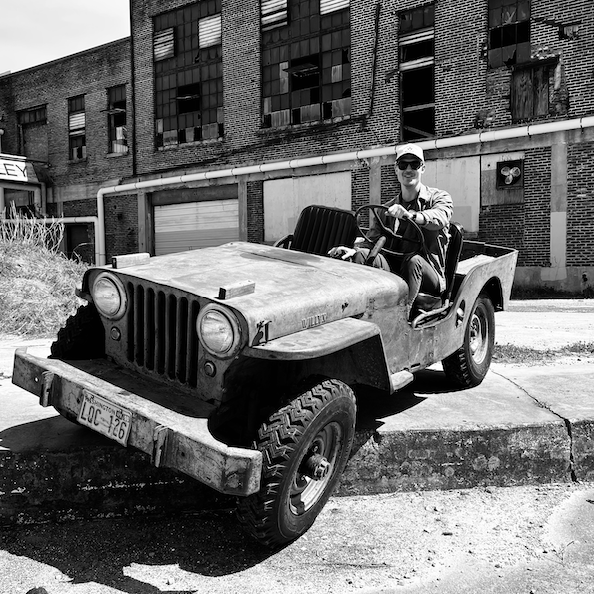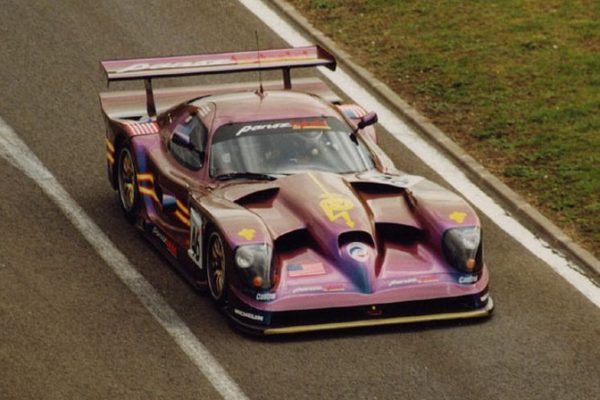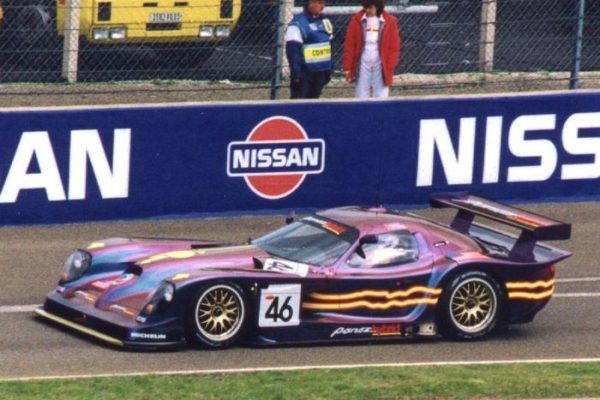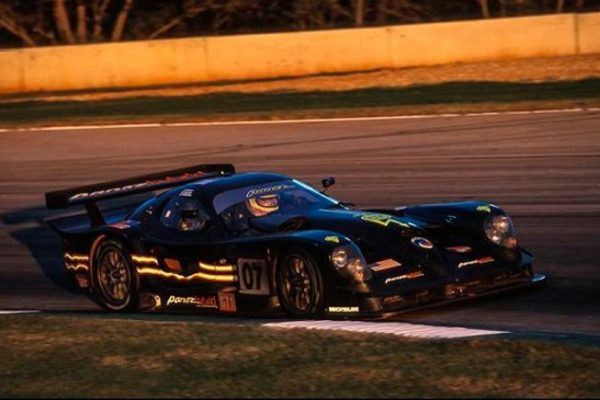Eight years before Formula 1 Management first intoned the word hybrid, and fifteen years before Audi claimed the first hybrid victory at Le Mans overall, there was Sparky.
The year was 1997. Don Panoz, founder of ALMS and father to Dan Panoz (founder of the eponymous race team), met with Zytek’s Bill Gibson in the wake of a disastrous Le Mans. That year, all of Panoz’s three new GTR-1s DNF’d. Undiscouraged, Panoz and Gibson took a look at the car’s struggles and started dreaming.
To the carbon-fiber monocoque, Panoz added length. The GTR-1’s nose and rear were stretched to increase downforce and aid stability in high-speed corners. The car’s aluminum V-8 was reconsidered, and the 4.6-liter Ford mill was ditched for a unit from NASCAR’s Roush Racing.
Curiously, a hybrid drivetrain was also proposed.
The GTR-1 Hybrid would run alongside the ICE GTR-1s, pairing batteries to an electric motor and that new 6.0-liter Roush V-8. The electric motor was intended to add a punch of low-end torque that’d haul Sparky out of slow corners, allowing the engine’s top-end to stretch its legs on the lengthy straights so common to endurance racing’s hallowed temples. Especially at La Sarthe.
That concept to bolster an engine’s low-end power vacuum with an electric boost, which we now call torque fill, was novel at the time.
Sparky’s batteries were hand-built by the German firm Varta, known for its line of consumer-facing products in Europe. Unlike modern vehicular battery cells, which are roughly brick-shaped and line the bottom of a vehicle like a paved road, Sparky’s batteries were tubular, running lengthwise on Sparky’s right side, butted against the motor. These nickel metal hydride batteries were anchor-like, and leveraged a far more rudimentary battery chemistry than what you’d find on a modern hybrid. (For OEMs these days, Nickel Manganese Cobalt and Nickel Cobalt Aluminum compositions are common, with more-advanced lithium ion cells making way for solid-state Lithium-metal compositions in the very near future). The battery array weighed in at about 350 pounds, according to Don Panoz.
Sparky’s single brushless DC electric motor was considerably more compact, at 16 inches long and 10 inches wide and connected to the driveshaft via the transaxle. Despite its size, the motor generated an uppercut of electric power. According to Panoz, the electric motor provided up to 30 percent of Sparky’s 650-horse, 500-lb-ft output. In turn, the battery and motor generated a huge amount of magnetic energy.
“If you were in the same room with this car and you were working on it, you’d have to leave your credit cards and stuff outside, because it would just swipe all the magnetic strips,” Panoz said of Sparky’s development.
Like modern F1 cars, Sparky’s batteries were regenerated by braking forces, rather than a generator leeching power from the engine, or the (frankly terrifying) flywheel solution that gripped the minds of racing engineers there for a minute.
But unlike modern F1 cars, Sparky was a heavyweight, dragging across the scales at 2400 lbs., several hundred pounds more than a competitive non-hybrid at the time. Still, Panoz theorized straight-line pace would offset the weight penalty. And crucially, for endurance racing, the batteries would offer a huge boost in efficiency.
To denote its hybrid optimism, Panoz lavished Sparky with one of the all-time paint jobs, a striking yellow flame motif laid over a deep, luscious, iridescent purple. (Side note: when will we, as a community, ditch the same five Sixties Porsche liveries for the dials of our racing chronographs? TAG Heuer: the time for a Sparky Carrera is nigh.)
In Sparky, Panoz created the first modern hybrid endurance racer. Just consider all the boxes it ticked, decades before hybrids would dominate every major racing series on earth. But success would not find this curious, groundbreaking hybrid, even though Panoz shipped the car to Le Mans in 1998 with a tank full of optimism.
During qualifying, Panoz explained in a retrospective video, the team forgot to remove enough batteries to secure a competitive time; Sparky didn’t manage to make the race. It’s a gentle way of acknowledging that Sparky was miles off the pace that season, with a development plagued by electrical reliability issues and an ICE sibling that was moving up to the of the time sheets.
Still, Sparky’s development persisted alongside that of the remaining conventional GTR-1s.
Later that season, Sparky secured a class victory and 12th overall at the inaugural Petit Le Mans. But with the greater success of the revised, ICE GTR-1s, Sparky was put up on a shelf for the years to follow. Still, Panoz had proved that a hybrid race car could win big endurance races, that the layout might provide a template for the future of racing itself.
Only the timing was all wrong.
“We were really enthused,” Don Panoz said of the win at Petit Le Mans. “I went around to see the manufacturers with this concept, that we could prove that a hybrid could really perform, and on the basis of the hybrid, could win races. In 1998 I can tell you, none of the OEMs were interested in building a hybrid car.”
As our own Marshall Pruett noted in Don Panoz’s obituary, the elder Panoz became a legend of American racing because he was willing to take big chances. In an era when racing became increasingly insular, when European firms dictated a singular approach to engineering, and fans were increasingly isolated from the excitement of the sport, Panoz dared.
Sparky was a guiding light that arrived decades ahead of its time, but proof that bright ideas and the people who chase them ultimately dictate racing’s future.

Senior Editor
The only member of staff to flip a grain truck on its roof, Kyle Kinard is R&T’s senior editor and resident malcontent. He lives near Seattle and enjoys the rain. His column, Kinardi Line, runs when it runs.
Eight years before Formula 1 Management first intoned the word hybrid, and fifteen years before Audi claimed the first hybrid victory at Le Mans overall, there was Sparky.
The year was 1997. Don Panoz, founder of ALMS and father to Dan Panoz (founder of the eponymous race team), met with Zytek’s Bill Gibson in the wake of a disastrous Le Mans. That year, all of Panoz’s three new GTR-1s DNF’d. Undiscouraged, Panoz and Gibson took a look at the car’s struggles and started dreaming.
To the carbon-fiber monocoque, Panoz added length. The GTR-1’s nose and rear were stretched to increase downforce and aid stability in high-speed corners. The car’s aluminum V-8 was reconsidered, and the 4.6-liter Ford mill was ditched for a unit from NASCAR’s Roush Racing.
Curiously, a hybrid drivetrain was also proposed.
The GTR-1 Hybrid would run alongside the ICE GTR-1s, pairing batteries to an electric motor and that new 6.0-liter Roush V-8. The electric motor was intended to add a punch of low-end torque that’d haul Sparky out of slow corners, allowing the engine’s top-end to stretch its legs on the lengthy straights so common to endurance racing’s hallowed temples. Especially at La Sarthe.
That concept to bolster an engine’s low-end power vacuum with an electric boost, which we now call torque fill, was novel at the time.
Sparky’s batteries were hand-built by the German firm Varta, known for its line of consumer-facing products in Europe. Unlike modern vehicular battery cells, which are roughly brick-shaped and line the bottom of a vehicle like a paved road, Sparky’s batteries were tubular, running lengthwise on Sparky’s right side, butted against the motor. These nickel metal hydride batteries were anchor-like, and leveraged a far more rudimentary battery chemistry than what you’d find on a modern hybrid. (For OEMs these days, Nickel Manganese Cobalt and Nickel Cobalt Aluminum compositions are common, with more-advanced lithium ion cells making way for solid-state Lithium-metal compositions in the very near future). The battery array weighed in at about 350 pounds, according to Don Panoz.
Sparky’s single brushless DC electric motor was considerably more compact, at 16 inches long and 10 inches wide and connected to the driveshaft via the transaxle. Despite its size, the motor generated an uppercut of electric power. According to Panoz, the electric motor provided up to 30 percent of Sparky’s 650-horse, 500-lb-ft output. In turn, the battery and motor generated a huge amount of magnetic energy.
“If you were in the same room with this car and you were working on it, you’d have to leave your credit cards and stuff outside, because it would just swipe all the magnetic strips,” Panoz said of Sparky’s development.
Like modern F1 cars, Sparky’s batteries were regenerated by braking forces, rather than a generator leeching power from the engine, or the (frankly terrifying) flywheel solution that gripped the minds of racing engineers there for a minute.
But unlike modern F1 cars, Sparky was a heavyweight, dragging across the scales at 2400 lbs., several hundred pounds more than a competitive non-hybrid at the time. Still, Panoz theorized straight-line pace would offset the weight penalty. And crucially, for endurance racing, the batteries would offer a huge boost in efficiency.
To denote its hybrid optimism, Panoz lavished Sparky with one of the all-time paint jobs, a striking yellow flame motif laid over a deep, luscious, iridescent purple. (Side note: when will we, as a community, ditch the same five Sixties Porsche liveries for the dials of our racing chronographs? TAG Heuer: the time for a Sparky Carrera is nigh.)
In Sparky, Panoz created the first modern hybrid endurance racer. Just consider all the boxes it ticked, decades before hybrids would dominate every major racing series on earth. But success would not find this curious, groundbreaking hybrid, even though Panoz shipped the car to Le Mans in 1998 with a tank full of optimism.
During qualifying, Panoz explained in a retrospective video, the team forgot to remove enough batteries to secure a competitive time; Sparky didn’t manage to make the race. It’s a gentle way of acknowledging that Sparky was miles off the pace that season, with a development plagued by electrical reliability issues and an ICE sibling that was moving up to the of the time sheets.
Still, Sparky’s development persisted alongside that of the remaining conventional GTR-1s.
Later that season, Sparky secured a class victory and 12th overall at the inaugural Petit Le Mans. But with the greater success of the revised, ICE GTR-1s, Sparky was put up on a shelf for the years to follow. Still, Panoz had proved that a hybrid race car could win big endurance races, that the layout might provide a template for the future of racing itself.
Only the timing was all wrong.
“We were really enthused,” Don Panoz said of the win at Petit Le Mans. “I went around to see the manufacturers with this concept, that we could prove that a hybrid could really perform, and on the basis of the hybrid, could win races. In 1998 I can tell you, none of the OEMs were interested in building a hybrid car.”
As our own Marshall Pruett noted in Don Panoz’s obituary, the elder Panoz became a legend of American racing because he was willing to take big chances. In an era when racing became increasingly insular, when European firms dictated a singular approach to engineering, and fans were increasingly isolated from the excitement of the sport, Panoz dared.
Sparky was a guiding light that arrived decades ahead of its time, but proof that bright ideas and the people who chase them ultimately dictate racing’s future.

Senior Editor
The only member of staff to flip a grain truck on its roof, Kyle Kinard is R&T’s senior editor and resident malcontent. He lives near Seattle and enjoys the rain. His column, Kinardi Line, runs when it runs.
Eight years before Formula 1 Management first intoned the word hybrid, and fifteen years before Audi claimed the first hybrid victory at Le Mans overall, there was Sparky.
The year was 1997. Don Panoz, founder of ALMS and father to Dan Panoz (founder of the eponymous race team), met with Zytek’s Bill Gibson in the wake of a disastrous Le Mans. That year, all of Panoz’s three new GTR-1s DNF’d. Undiscouraged, Panoz and Gibson took a look at the car’s struggles and started dreaming.
To the carbon-fiber monocoque, Panoz added length. The GTR-1’s nose and rear were stretched to increase downforce and aid stability in high-speed corners. The car’s aluminum V-8 was reconsidered, and the 4.6-liter Ford mill was ditched for a unit from NASCAR’s Roush Racing.
Curiously, a hybrid drivetrain was also proposed.
The GTR-1 Hybrid would run alongside the ICE GTR-1s, pairing batteries to an electric motor and that new 6.0-liter Roush V-8. The electric motor was intended to add a punch of low-end torque that’d haul Sparky out of slow corners, allowing the engine’s top-end to stretch its legs on the lengthy straights so common to endurance racing’s hallowed temples. Especially at La Sarthe.
That concept to bolster an engine’s low-end power vacuum with an electric boost, which we now call torque fill, was novel at the time.
Sparky’s batteries were hand-built by the German firm Varta, known for its line of consumer-facing products in Europe. Unlike modern vehicular battery cells, which are roughly brick-shaped and line the bottom of a vehicle like a paved road, Sparky’s batteries were tubular, running lengthwise on Sparky’s right side, butted against the motor. These nickel metal hydride batteries were anchor-like, and leveraged a far more rudimentary battery chemistry than what you’d find on a modern hybrid. (For OEMs these days, Nickel Manganese Cobalt and Nickel Cobalt Aluminum compositions are common, with more-advanced lithium ion cells making way for solid-state Lithium-metal compositions in the very near future). The battery array weighed in at about 350 pounds, according to Don Panoz.
Sparky’s single brushless DC electric motor was considerably more compact, at 16 inches long and 10 inches wide and connected to the driveshaft via the transaxle. Despite its size, the motor generated an uppercut of electric power. According to Panoz, the electric motor provided up to 30 percent of Sparky’s 650-horse, 500-lb-ft output. In turn, the battery and motor generated a huge amount of magnetic energy.
“If you were in the same room with this car and you were working on it, you’d have to leave your credit cards and stuff outside, because it would just swipe all the magnetic strips,” Panoz said of Sparky’s development.
Like modern F1 cars, Sparky’s batteries were regenerated by braking forces, rather than a generator leeching power from the engine, or the (frankly terrifying) flywheel solution that gripped the minds of racing engineers there for a minute.
But unlike modern F1 cars, Sparky was a heavyweight, dragging across the scales at 2400 lbs., several hundred pounds more than a competitive non-hybrid at the time. Still, Panoz theorized straight-line pace would offset the weight penalty. And crucially, for endurance racing, the batteries would offer a huge boost in efficiency.
To denote its hybrid optimism, Panoz lavished Sparky with one of the all-time paint jobs, a striking yellow flame motif laid over a deep, luscious, iridescent purple. (Side note: when will we, as a community, ditch the same five Sixties Porsche liveries for the dials of our racing chronographs? TAG Heuer: the time for a Sparky Carrera is nigh.)
In Sparky, Panoz created the first modern hybrid endurance racer. Just consider all the boxes it ticked, decades before hybrids would dominate every major racing series on earth. But success would not find this curious, groundbreaking hybrid, even though Panoz shipped the car to Le Mans in 1998 with a tank full of optimism.
During qualifying, Panoz explained in a retrospective video, the team forgot to remove enough batteries to secure a competitive time; Sparky didn’t manage to make the race. It’s a gentle way of acknowledging that Sparky was miles off the pace that season, with a development plagued by electrical reliability issues and an ICE sibling that was moving up to the of the time sheets.
Still, Sparky’s development persisted alongside that of the remaining conventional GTR-1s.
Later that season, Sparky secured a class victory and 12th overall at the inaugural Petit Le Mans. But with the greater success of the revised, ICE GTR-1s, Sparky was put up on a shelf for the years to follow. Still, Panoz had proved that a hybrid race car could win big endurance races, that the layout might provide a template for the future of racing itself.
Only the timing was all wrong.
“We were really enthused,” Don Panoz said of the win at Petit Le Mans. “I went around to see the manufacturers with this concept, that we could prove that a hybrid could really perform, and on the basis of the hybrid, could win races. In 1998 I can tell you, none of the OEMs were interested in building a hybrid car.”
As our own Marshall Pruett noted in Don Panoz’s obituary, the elder Panoz became a legend of American racing because he was willing to take big chances. In an era when racing became increasingly insular, when European firms dictated a singular approach to engineering, and fans were increasingly isolated from the excitement of the sport, Panoz dared.
Sparky was a guiding light that arrived decades ahead of its time, but proof that bright ideas and the people who chase them ultimately dictate racing’s future.

Senior Editor
The only member of staff to flip a grain truck on its roof, Kyle Kinard is R&T’s senior editor and resident malcontent. He lives near Seattle and enjoys the rain. His column, Kinardi Line, runs when it runs.
Eight years before Formula 1 Management first intoned the word hybrid, and fifteen years before Audi claimed the first hybrid victory at Le Mans overall, there was Sparky.
The year was 1997. Don Panoz, founder of ALMS and father to Dan Panoz (founder of the eponymous race team), met with Zytek’s Bill Gibson in the wake of a disastrous Le Mans. That year, all of Panoz’s three new GTR-1s DNF’d. Undiscouraged, Panoz and Gibson took a look at the car’s struggles and started dreaming.
To the carbon-fiber monocoque, Panoz added length. The GTR-1’s nose and rear were stretched to increase downforce and aid stability in high-speed corners. The car’s aluminum V-8 was reconsidered, and the 4.6-liter Ford mill was ditched for a unit from NASCAR’s Roush Racing.
Curiously, a hybrid drivetrain was also proposed.
The GTR-1 Hybrid would run alongside the ICE GTR-1s, pairing batteries to an electric motor and that new 6.0-liter Roush V-8. The electric motor was intended to add a punch of low-end torque that’d haul Sparky out of slow corners, allowing the engine’s top-end to stretch its legs on the lengthy straights so common to endurance racing’s hallowed temples. Especially at La Sarthe.
That concept to bolster an engine’s low-end power vacuum with an electric boost, which we now call torque fill, was novel at the time.
Sparky’s batteries were hand-built by the German firm Varta, known for its line of consumer-facing products in Europe. Unlike modern vehicular battery cells, which are roughly brick-shaped and line the bottom of a vehicle like a paved road, Sparky’s batteries were tubular, running lengthwise on Sparky’s right side, butted against the motor. These nickel metal hydride batteries were anchor-like, and leveraged a far more rudimentary battery chemistry than what you’d find on a modern hybrid. (For OEMs these days, Nickel Manganese Cobalt and Nickel Cobalt Aluminum compositions are common, with more-advanced lithium ion cells making way for solid-state Lithium-metal compositions in the very near future). The battery array weighed in at about 350 pounds, according to Don Panoz.
Sparky’s single brushless DC electric motor was considerably more compact, at 16 inches long and 10 inches wide and connected to the driveshaft via the transaxle. Despite its size, the motor generated an uppercut of electric power. According to Panoz, the electric motor provided up to 30 percent of Sparky’s 650-horse, 500-lb-ft output. In turn, the battery and motor generated a huge amount of magnetic energy.
“If you were in the same room with this car and you were working on it, you’d have to leave your credit cards and stuff outside, because it would just swipe all the magnetic strips,” Panoz said of Sparky’s development.
Like modern F1 cars, Sparky’s batteries were regenerated by braking forces, rather than a generator leeching power from the engine, or the (frankly terrifying) flywheel solution that gripped the minds of racing engineers there for a minute.
But unlike modern F1 cars, Sparky was a heavyweight, dragging across the scales at 2400 lbs., several hundred pounds more than a competitive non-hybrid at the time. Still, Panoz theorized straight-line pace would offset the weight penalty. And crucially, for endurance racing, the batteries would offer a huge boost in efficiency.
To denote its hybrid optimism, Panoz lavished Sparky with one of the all-time paint jobs, a striking yellow flame motif laid over a deep, luscious, iridescent purple. (Side note: when will we, as a community, ditch the same five Sixties Porsche liveries for the dials of our racing chronographs? TAG Heuer: the time for a Sparky Carrera is nigh.)
In Sparky, Panoz created the first modern hybrid endurance racer. Just consider all the boxes it ticked, decades before hybrids would dominate every major racing series on earth. But success would not find this curious, groundbreaking hybrid, even though Panoz shipped the car to Le Mans in 1998 with a tank full of optimism.
During qualifying, Panoz explained in a retrospective video, the team forgot to remove enough batteries to secure a competitive time; Sparky didn’t manage to make the race. It’s a gentle way of acknowledging that Sparky was miles off the pace that season, with a development plagued by electrical reliability issues and an ICE sibling that was moving up to the of the time sheets.
Still, Sparky’s development persisted alongside that of the remaining conventional GTR-1s.
Later that season, Sparky secured a class victory and 12th overall at the inaugural Petit Le Mans. But with the greater success of the revised, ICE GTR-1s, Sparky was put up on a shelf for the years to follow. Still, Panoz had proved that a hybrid race car could win big endurance races, that the layout might provide a template for the future of racing itself.
Only the timing was all wrong.
“We were really enthused,” Don Panoz said of the win at Petit Le Mans. “I went around to see the manufacturers with this concept, that we could prove that a hybrid could really perform, and on the basis of the hybrid, could win races. In 1998 I can tell you, none of the OEMs were interested in building a hybrid car.”
As our own Marshall Pruett noted in Don Panoz’s obituary, the elder Panoz became a legend of American racing because he was willing to take big chances. In an era when racing became increasingly insular, when European firms dictated a singular approach to engineering, and fans were increasingly isolated from the excitement of the sport, Panoz dared.
Sparky was a guiding light that arrived decades ahead of its time, but proof that bright ideas and the people who chase them ultimately dictate racing’s future.

Senior Editor
The only member of staff to flip a grain truck on its roof, Kyle Kinard is R&T’s senior editor and resident malcontent. He lives near Seattle and enjoys the rain. His column, Kinardi Line, runs when it runs.

















